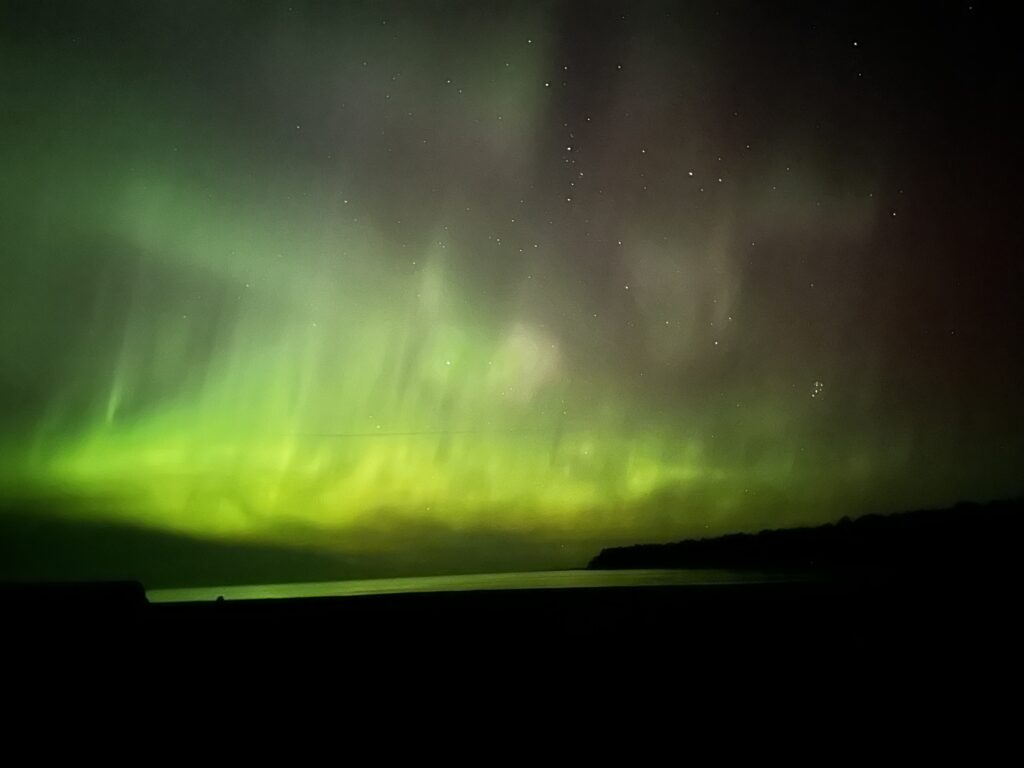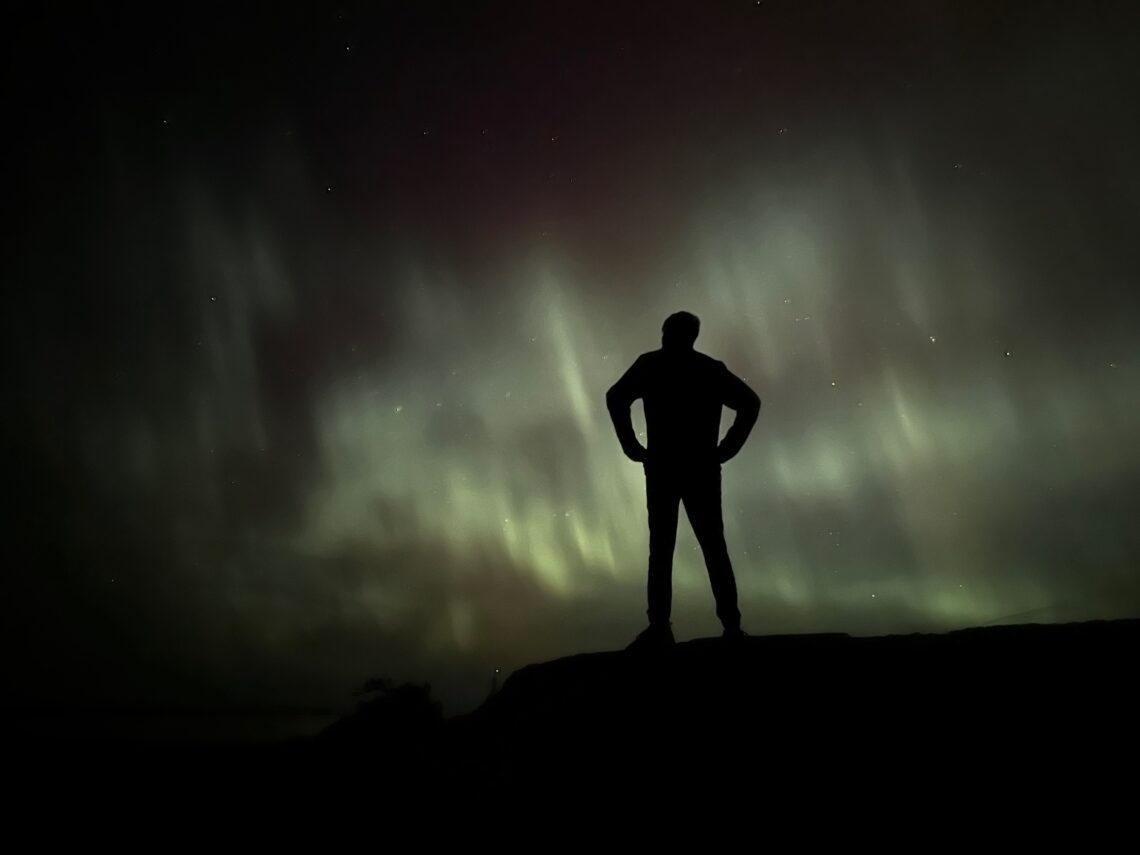I have been wanting to blog about this for quite sometime. Better late than never.
Several weeks ago, a spectacular light show appeared over parts of the United States and Canada. The northern lights – or “aurora borealis” – are beautiful, colorful waves from above that captivate those lucky enough to see them.
One account I had read called this atmospheric phenomenon “the Holy Grail of skywatching.” Indeed.
Think of the darkest night sky you’ve ever seen. Add bursts of yellow and green staining the horizon. Maybe dollops of red and purple blotches that paint pillars and curtains.
Imagine a geomagnetic storm of epic proportions. Right over your head.
Science isn’t my forte, so I wanted to learn more about how and why this happens. The gist, according to a NASA article: Energized particles from the sun slam into Earth’s upper atmosphere at speeds of up to 45 million mph, but our planet’s magnetic field protects us from the onslaught.
As Earth’s magnetic field redirects the particles toward the North and South poles (apparently, there are “southern lights,” too), the dramatic process becomes a cinematic feast for the eyes.
I’m not surprised that Italian astronomer Galileo Galilei coined the name of this beautiful sight in 1619. “Aurora borealis” comes from Aurora, the Roman goddess of dawn, and Boreas, the Greek god of the north wind.

For most city dwellers, the night skies of September 18 were much too bright to offer this magnificent sighting. Unless you happened to be in the right place at the right time. I wasn’t.
But my eldest great-nephew was – way up in the northernmost part of Michigan’s Upper Peninsula. It’s called the Keweenaw Peninsula and juts out into Lake Superior, one of our five Great Lakes here in Mittenland. He took the photos featured in this post … with an iPhone no less!
The area was the site of America’s first copper boom. That’s why it’s called “Copper Country.” The mines are long gone, but it’s still home to logging and tourism.
Over the past year or so, I had observed this now 19-year-old wunderkind plotting his college search strategy with the creativity of a novelist, the analysis of a scientist and the gumption of a financial wizard to get the best bang for his buck. With those qualities, it’s no wonder Michael’s majoring in mechanical engineering. Smart cookie.
He thought long and hard about where to go. Big school. Small school. Public school. Prestigious school. Community college.
He weighed whether to go in state or out, and to live at home or on campus.
He applied for grants, scholarships and anything else to help cover the ever-increasing (ridiculous) cost of tuition.
He used something called the “Common App” that allows prospective students to send applications to multiple schools at once. (After reading their step-by-step how-to guide, I felt as if I needed to go back to school myself.)
He worked all summer at not one but two jobs to save money.
He wrote a really good essay.
I guess that’s a roundabout way of saying that he took great care to find the right path – for him – in forging the next chapter of his life.
Although he was accepted to several top schools, he chose the one that best suited him. It’s nearly 10 hours away in the middle of nowhere.
Am I worried that winters up there are bitter cold and the area gets 300 inches of snow per season? (Yes, I am.) Do I think the team mascot is lame? (No, I do not. Go, Huskies!)
But seriously, I suspect no matter what my great-nephew ends up doing, he will be fine. And not just because he’s a smart and talented young man with a keen eye for classic Mustangs.
He’s a good navigator. In the sense of maneuvering himself through college (read: life) with more than tunnel vision and the task at hand.
I mean, heck, he was up there and got to see the northern lights!
They say how you spend your college years — not necessarily where — is what matters most in the long run.
How do I know this, you ask? Honestly, I lived it.
I went to the university that I could afford, not necessarily the one I had dreamed of attending. That was Oakland University in Rochester, Michigan, versus Michigan State University in East Lansing. Or the University of Missouri School of Journalism. Or Columbia University in New York City.
Things turned out pretty well, even though it took a shade longer than four years for me to graduate since I worked and attended night school for part of it. You do what you have to do.
But while at OU, I did everything I could to make the most of my college experience — even if I was commuting and working part time. I lived with my parents to save money. I worked for the university’s newspaper, interned at The Oakland Press and even did a stint at WDIV-Ch. 4 news.
I prayed for parking. Every. Single. Day.
I nearly gave up when money dried up and things got “too hard.” Truth is, those excuses were just plain silly. The opportunity to attend college was a gift. I was the first in my family to go.
Quitting wasn’t an option for this girl in 1978.
Of course, that was a long, long time ago, and the world has changed more than I ever imagined, including the cost of college.
According to Education Data Initiative, the average cost of attendance for a student living on campus at a public, four-year in-state institution is $26,027 per year, or $104,108 over four years. Out-of-state students pay more.
Private, nonprofit university students pay $55,840 per year or $223,360 over four years. Think Ivy League schools on the East Coast.
Wow. Just wow. It took me 20 years in the workplace to earn anything close to $50,000 a year.
I’m grateful Michael understands that some things remain true about these pivotal college years. I trust that he will continue to navigate them with as much care as he did getting there to get the most out of college.
Like watching the northern lights on a Monday in September outside in the middle of nowhere.






10 Comments
Jana
Perfect!
Jennifer John
Thanks, Jana.
Julie M Sayers
We were at Oakland around the same time. Got my masters in education there in 1977. Costs now are crazy!
Jennifer John
Darn, wish I’d known you then! Thanks, Julie.
Martha
Love this one, J! Michael sounds amazing. Did you mention to Bob or Erin that you worked for a bit at WDIV? Oh, and congrats on being the first college grad. Proud of you!
Jennifer John
Thanks so much, Bamz. Yep and yep.
Elaine
Loved this, Jen! He sounds like an amazing young man who will do wonderful things, and a lucky one, too, to have an auntie like you!
Jennifer John
He is! Thanks, E.
Sandra Lupo
So proud of you, Jin! And never forget all your accomplishments. Love you!
Jennifer John
Back atcha, sis! xxoo